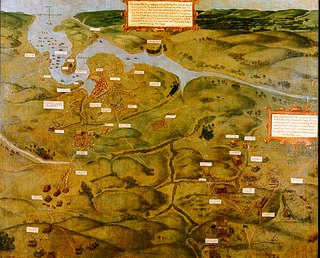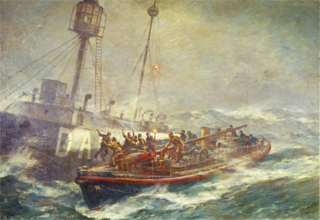Related Research Articles

Tramore is a seaside town in County Waterford, on the southeast coast of Ireland. It has a population of 11,277 as per the 2022 census, the second largest town in the county.
The Margate surfboat refers to three surfboats used for maritime rescue at Margate, on the eastern tip of Kent. They were run as cooperatives, with local boatmen clubbing together to buy them and then receiving a share of any salvage money received.

The siege of Kinsale, also known as the battle of Kinsale, was the ultimate battle in England's conquest of Gaelic Ireland, commencing in October 1601, near the end of the reign of Queen Elizabeth I, and at the climax of the Nine Years' War—a campaign by Hugh O'Neill, Hugh Roe O'Donnell and other Irish lords against English rule.
A seahorse is a marine fish belonging to the genus Hippocampus.
Events from the year 1816 in the United Kingdom.
The 82nd Regiment of Foot (Prince of Wales's Volunteers) was an infantry regiment of the British Army, raised in 1793. Under the Childers Reforms it amalgamated with the 40th (the 2nd Somersetshire) Regiment of Foot to form the Prince of Wales's Volunteers (South Lancashire Regiment) in 1881.
Events from the year 1816 in Ireland.
Rochdale and Prince of Wales were two troop ships that sank in Dublin Bay in 1807.

The action of 13 January 1797 was a minor naval battle fought between a French ship of the line and two British frigates off the coast of Brittany during the French Revolutionary Wars. During the action the frigates outmanoeuvred the much larger French vessel and drove it onto shore in heavy seas, resulting in the deaths of between 400 and 1,000 of the 1,300 persons aboard. One of the British frigates was also lost in the engagement with six sailors drowned after running onto a sandbank while failing to escape a lee shore.

The French expedition to Ireland, known in French as the Expédition d'Irlande, was an unsuccessful attempt by the French Republic to assist the outlawed Society of United Irishmen, a popular rebel Irish republican group, in their planned rebellion against British rule during the French Revolutionary Wars. The French intended to land a large expeditionary force in Ireland during the winter of 1796–1797 which would join with the United Irishmen and drive the British out of Ireland. The French anticipated that this would be a major blow to British morale, prestige and military effectiveness, and was also intended to possibly be the first stage of an eventual invasion of Great Britain itself. To this end, the Directory gathered a force of approximately 15,000 soldiers at Brest under General Lazare Hoche during late 1796, in readiness for a major landing at Bantry Bay in December.

RNLB Mary Stanford was the Ballycotton Lifeboat from 1930 to 1959. Ballycotton is on Ireland's southern coast, a trade route to the Americas. There are many dangerous rocks and shallows with on-shore prevailing winds. Ballycotton has a long tradition of life-saving. Mary Stanford had 41 rescues, or "shouts", and saved 122 lives. She performed the notable Daunt Lightship rescue on 11 February 1936. After her withdrawal from service she lay for some years in a backwater of Dublin's Grand Canal Dock, but has now been returned to Ballycotton and restored.
In 1775 a vessel variously named Rockingham, Castle Rockingham, or Marquis of Rockingham wrecked on the Irish coast with loss of life.
Several ships have been named Lord Melville after one of the Viscounts Melville:
Lord Melville was launched at Blythe in 1810. Lloyd's Register reported her master as William Lewis, her owner as Holland & Co., and her trade as London–W__.

The Danish Auxiliary Corps was a corps of 7,000 Danish soldiers sent to fight with William of Orange who was at war in Ireland. Disappointed with his alliance with France's King Louis XIV, Christian V of Denmark–Norway in 1689 entered into a treaty of military assistance with King William III of England. The corps was transported to Ireland, fighting against the Jacobites, participating in the battles of the Boyne and Aughrim, as well as the sieges of Limerick, Cork, Kinsale, Athlone, and Galway. In early 1692 the corps was transported to Flanders for future service in English pay.

Captain Herbert John Clifford was an officer in the Royal Navy during the Napoleonic Wars and the founder of the Loochoo Naval Mission (1843). In 1818, he published Vocabulary of the Language Spoken at the Great Loo-Choo Island, in the Japan Sea, which "remained the single most important source on Ryukyuan in the West for decades."
Lord Wellington was launched in 1810 at Rochester, or equally, Chatham, as a West Indiaman. She made at least one voyage to India under a license from the British East India Company (EIC). She then made a voyage to New South Wales transporting female convicts from England and Ireland. She was lost in December 1822 off Denmark while sailing from Saint Petersburg to London.
Sea Horse was launched in 1782 at Gravesend for the Hudson's Bay Company. She then became a merchantman that a French naval squadron captured in 1795. She next became the Spanish merchantman Principe Fernando, which a Guernsey privateer recaptured in January 1800. She became a merchantman again, and then made one voyage as a whaler. She became a Government transport and it was as a transport that she was wrecked in 1816 with great loss of life.
References
- ↑ Rev R. H. Rylan (1824). History of the County and City of Waterford. p. 167.
- 1 2 3 4 5 6 7 8 9 10 11 12 13 14 15 "The Regiment's Greatest Tragedy – The Wrecking of the Seahorse, Lord Melville & Boadicea". Lancashire Infantry Museum.
- ↑ J. J. MacGregor (1816). Narrative of the loss of the Sea-Horse Transport, Captain Gibbs, in the Bay of Tramore, ... also some account of the wreck of the Lord Melville and Boadicea Transports, etc. John Bull.